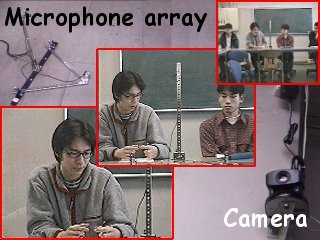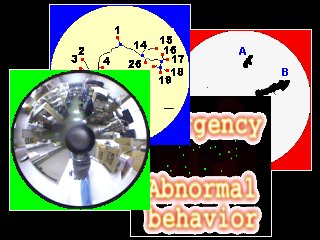 Intelligent Camera Work which Shoots a Lecture Scene using Plural Cameras
Intelligent Camera Work which Shoots a Lecture Scene using Plural Cameras
In this research, we propose a computer-controlled intelligent camera work
system which shoots a lecture scene as cameramen
and selects a best image among plural video images as a switcher.
In the first, to understand the situation of lecture,
our system estimates actions of a lecturer
on the basis of extracted movements of a lecturer
and written characters on a blackboard.
In the next, each camera fixes
a shooting region based on the lecturers actions.
In the last, our system selects the best image among plural images
by evaluating each of the images.
And we tried an experiment of shooting the lecture
and have confirmed the effectiveness of our approach
from the subjective evaluation of the students.
 Production of TV Conference Video Images using Visual and Auditory Information
Production of TV Conference Video Images using Visual and Auditory Information
TV conference systems have been widely used recently.
A participant of each site proceeds with a TV conference
using video image on a screen and voice of a partner site.
In this case, a fixed video camera shoots a scene of a site in general.
The video image taken by a fixed camera, however, is lacking in changes.
Also the fixed camera does not take shots efficiency
that the participants of a partner site pay attention.
As one of the candidates to avoid these defects,
there is a method that the computer-controlled cameras shoots the scene.
In this paper, we propose an algorithm of shooting the best shot
by computer-controlled cameras.
The shooting algorithm is mainly decided by
estimating an area of the image with high degree of attention,
which is given by not only visual information
but also auditory information.
By using an experimental system,
we confirm the effectiveness of our approach
by examining a questionnaire from
the participants of TV conferences.
 The Monitoring System of Irregular State using Pattern of Person's Moving Locus
The Monitoring System of Irregular State using Pattern of Person's Moving Locus
We propose a monitoring system for a high aged person.
Using our this system, we intend to check non-daily moving patterns
of the object person, and reports (if necessary) an irregular state
of moving pattern to the monitoring facilities.
In general, the number of moving patterns would be limited in the case of
a high aged person living in a room.
It is possible to learn the frequently appeared moving patterns
by a system like a HMM system.
Moving patterns of the person is applied to the HMM system,
the system does not accept the input patterns in the case
when non-daily moving patterns appeared.
Such a case could be supposed an irregular state of
the living life of the object person.
Soon after, the system reports an alarm of happening of
the irregular state according to demand.
 Object Recognition and Active Vision
Object Recognition and Active Vision
A model-based object recognition is one of the
major active research field of computer vision,
and there have been many reports on this field.
However, in the case when an input image has occulusion or
there are models which have similar aspects,
it is hard to get the exact recognition result.
In our research, we control a camera based on
the degree of recognition ambiguity
which we define,
and our system integrates feature of the unknown object
extracted from sequential images while the camera moves to
the best position.
This approach promises a reliable
and high speed object recognition.
|
- Shigeki Aoki, Masaki Onishi, Atsuhiro Kojima, Kunio Fukunaga,
``Detection of a Solitude Sensor Irregular States Based on Learning and Recognition of Behavioral Patterns,''
IEEJ Trans. SM, vol.125, no.6, pp.259-265, June 2005.
 pdf file
pdf file
- Shigeki Aoki, Masaki Onishi, Atsuhiro Kojima, Kunio Fukunaga,
``Learning and Recognizing Behavioral Patterns Using Position and Posture of Human,''
Proc. of IEEE Conference on Cybernetics and Intelligent Systems, pp.1299-1302, Dec. 2004.
 pdf file
pdf file
- Masaki Onishi, Kunio Fukunaga,
``Shooting the Lecture Scene Using Computer-controlled Cameras
Based on Situation Understanding and Evaluation of Video Images,''
Proc. 17th International Conference on Pattern Recognition, vol.1, pp,781-784, Aug. 2004.
 pdf file
pdf file
- Masaki Onishi, Masashi Murakami, Kunio Fukunaga,
``A Method of Computer-controlled Camerawork for Lecture Video Considering Mental State of Students,''
Trans. IEICE (D-II), vol.J87-D-II, no.8, pp.1728-1734, Aug. 2004.(in Japanese)
 pdf file
pdf file
- Shigeki Aoki, Yoshio Iwai, Masaki Onishi, Atsuhiro Kojima, Kunio Fukunaga,
``Learning and Recognizing Behavioral Patterns Using Position and Posture of Human Body
and Its Application to Detection of Irregular State,''
Trans. IEICE (D-II), vol.J87-D-II, no.5, pp.1083-1093, May 2004.
(in Japanese)
 pdf file
pdf file
- Shigeki Aoki, Masaki Onishi, Atsuhiro Kojima, Kunio Fukunaga,
``Recognition of Behavioral Pattern Based on HMM,''
Trans. IEICE (D-II), vol.J85-D-II, no.7, pp.1265-1270, July 2002.
(in Japanese)
 pdf file
pdf file
- Masaki Onishi, Masashi Murakami, Kunio Fukunaga,
``Computer-Controlled Camera Work at Lecture Scene
Based on Situation Understanding and Evaluation of Video Images,''
Trans. IEICE (D-II), vol.J85-D-II, no.4, pp.594-603, April 2002.
(in Japanese)
 pdf file
pdf file
- Masaki Onishi, Takehiko Kagebayashi, Kunio Fukunaga,
``Production of Videoconferencing Images by Computer Controlled Camera
Based on Integration of Audiovisual Information,''
Trans. IEICE (D-II), vol.J85-D-II, no.3, pp.537-542, March 2002.
(in Japanese)
 pdf file
pdf file
- Masaki Onishi, Takehiko Kagebayashi, Kunio Fukunaga,
``Production of Video Images by Computer Controlled Cameras
and Its Application to TV Conference System,''
Proc. of IEEE Conference on Computer Vision and Pattern Recognition,
vol.2, II-131-II-137, Dec. 2001.
 pdf file
pdf file
- Masaki Onishi, Masao Izumi, Kunio Fukunaga,
``Blackboard Segmentation Using Video Image of Lecture and Its Applications,''
Trans. IEICE (D-I) Jpn, vol.J83-D-I, no.11, pp.1187-1195,
Nov. 2000. (in Japanese)
 pdf file
pdf file
- Masaki Onishi, Masao Izumi, Kunio Fukunaga,
``Production of Video Images by Computer Controlled Camera Operation
Based on Distribution of Spatiotemporal Mutual Information,''
Proc. 15th International Conference on Pattern Recognition,
Volume 4, pp.102-105, Sep. 2000.
 pdf file
pdf file
- Masaki Onishi, Masao Izumi, Kunio Fukunaga,
``Blackboard Segmentation Using Video Image of Lecture
and Its Applications,''
Proc. 15th International Conference on Pattern Recognition,
Volume 4, pp.615-618, Sep. 2000.
 pdf file
pdf file
- Katsunori Asanuma, Masaki Onishi, Atsuhiro Kojima, K. Fukunaga,
``Extracting Regions of Human Face and Hands
considering Information of Color and Region Tracking,''
T.IEEJ, vol.119-C,no.11, pp.1351-1358, Nov. 1999. (in Japanese)
 pdf file
pdf file
- Masaki Onishi, Masao Izumi, Kunio Fukunaga,
``Automatic Production of Video Images for Distance Learning System
Based on Distributed Information,''
Trans. IEICE (D-II) Jpn, vol.J82-D-II, no.10, pp.1590-1597, Oct. 1999. (in Japanese)
 pdf file
pdf file
- Masaki Onishi, Masao Izumi, Kunio Fukunaga,
``Object Recognition Using Sequential Images and
Application to Active Vision,''
SSPR'98 and SPR'98 Advances in Pattern Recognition,
pp.366-373, Aug. 1998.
 pdf file
pdf file
- Noboru Nishikawa, Masaki Onishi, Takuya Matsumoto,
Masao Izumi, Kunio Fukunaga,
``Object Recognition Based on Camera Control,''
T.IEEJ, vol.118-C, no.2, pp.210-216, Feb. 1998.
(in Japanese)
 pdf file
pdf file
|

 Search
Search
 Dictionary
Dictionary
 Traffic
Traffic
 Map
Map
 Weather
Weather

 Search
Search
 Dictionary
Dictionary
 Traffic
Traffic
 Map
Map
 Weather
Weather
 Intelligent Camera Work which Shoots a Lecture Scene using Plural Cameras
Intelligent Camera Work which Shoots a Lecture Scene using Plural Cameras
 Production of TV Conference Video Images using Visual and Auditory Information
Production of TV Conference Video Images using Visual and Auditory Information
 The Monitoring System of Irregular State using Pattern of Person's Moving Locus
The Monitoring System of Irregular State using Pattern of Person's Moving Locus
 Object Recognition and Active Vision
Object Recognition and Active Vision

